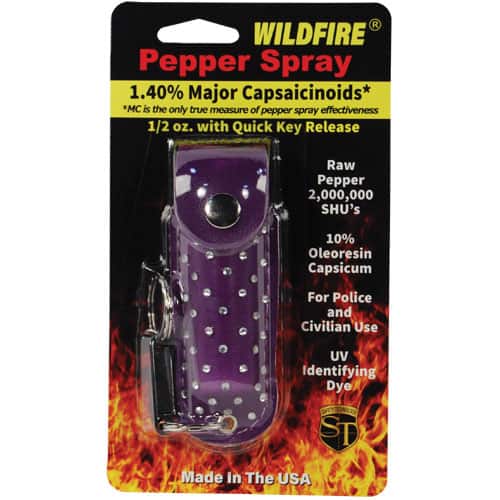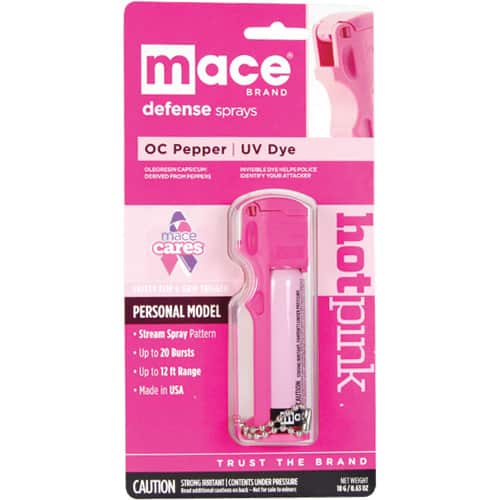They Both Pack A Powerful Punch
Are pepper spray and Mace the same? No, pepper spray and Mace aren’t the same, though they both pack a punch in self-defense. Pepper spray’s fiery ingredient, oleoresin capsicum (OC), causes searing pain, temporary blindness, and difficulty breathing, incapacitating an attacker long enough for you to escape. It’s legal in all 50 states, but rules vary, so check your local regulations.
Mace, once a term for CN tear gas products, has evolved. Now, it includes OC for enhanced effectiveness, aligning more closely with pepper spray standards. Both are potent, but understanding their differences is essential for your safety. Get to know the specifics, and you’ll be better prepared to choose the right protection for you.
Key Takeaways
- Pepper spray primarily uses oleoresin capsicum (OC), while Mace historically utilized CN tear gas.
- Mace has evolved to include OC in its composition, enhancing safety and effectiveness.
- Though often used interchangeably, Mace is a brand name, whereas pepper spray refers to the type of defense spray.
- Pepper spray is generally considered more effective and less toxic than the original CN-based Mace.
- Both products are legal for personal safety, but pepper spray’s OC content provides a broader range of incapacitation against threats.
Defining Pepper Spray

Pepper spray, a powerful self-defense tool, harnesses the intense pain of hot peppers through oleoresin capsicum (OC) to protect you in dangerous situations. This compact yet potent weapon is your ally, aiming directly at the eyes, nose, and mouth of an attacker. It releases a fiery wrath that can cause intense burning, temporary blindness, and even difficulty breathing. Imagine having the power of hot peppers at your disposal, ready to defend yourself at a moment’s notice.
In all 50 states, you’re empowered to carry pepper spray, a proof of its recognized effectiveness and reliability for personal safety. The beauty of it? The effects last about 30 minutes—ample time to make your escape and seek help. When faced with a threat, a quick spray can incapacitate your assailant, giving you the upper hand.
Navigating through life’s unpredictable moments, pepper spray stands as a beacon of protection. Its active ingredient, oleoresin capsicum, is your guardian, ensuring that you’re never truly alone. Embrace this tool, and you’ll walk with a newfound confidence, knowing you have what it takes to defend yourself.
Understanding Mace

Much like pepper spray, Mace has evolved over the years, initially containing CN tear gas but now often incorporating the same oleoresin capsicum (OC) for enhanced effectiveness. Originally, Mace’s use of CN tear gas proved less effective on individuals under the influence, driving the need for a more potent formula. Enter oleoresin capsicum (OC), a game-changer that not only made Mace more effective but also less toxic, aligning it closer to the modern demands of self-defense.
You’ll find that Mace is a brand name that’s become synonymous with spraying agents, much like Band-Aids for all bandages. This universal usage underscores its popularity but can also blur the lines when trying to understand the difference between traditional Mace and other defense sprays. It’s important to grasp that the active agents in Mace have transformed over time, aiming to offer you a more effective and safer means of protection.
Understanding the evolution from CN tear gas to oleoresin capsicum (OC) in Mace formulations is significant. It’s not just about knowing what’s in your self-defense tool; it’s about ensuring you’re equipped with something that offers real protection when you need it most.
Key Differences
While both serve as self-defense tools, the key differences between Mace and pepper spray lie in their active ingredients and legal statuses across states. Mace, historically a brand name synonymous with CN tear gas, contrasts sharply with pepper spray, which uses oleoresin capsicum (OC) as its active agent. This distinction is important because pepper spray works by causing an immediate burning sensation, proving to be more effective and less toxic than its traditional counterpart.
Pepper spray’s legality across all 50 states, with specific regulations varying by location, emphasizes the importance of understanding these distinctions. For instance, while you’re free to carry pepper spray in most places, states like California and New York impose their own rules, such as limiting canister sizes or controlling where you can buy them.
Grasping the Mace vs. pepper spray debate isn’t just about knowing which brand to pick; it’s about recognizing the significant differences in how each product works. This knowledge ensures you’re making an informed decision, choosing a self-defense tool that’s right for you, legal to carry, and effective in protecting your safety.
You can watch an informative video about Pepper Spray versus Mace right here.
Usage and Safety
Understanding the differences between Mace and pepper spray lays the groundwork for grasping their vital and ensuring effective usage. When you use pepper spray, it’s essential to master disarming and aiming techniques quickly. Knowing how to access your spray efficiently during emergencies can make a significant difference in your personal safety.
First off, familiarize yourself with the effective range of your pepper spray model. This knowledge is essential to maximize its effectiveness when it counts. Always aim for the face of your target; this ensures the best results, as the eyes and respiratory system are most affected. After using pepper spray, the immediate goal is to escape to safety while your attacker is stunned. This window is your opportunity to put distance between yourself and the threat.
Learning the proper techniques for using pepper spray isn’t just about self-defense; it’s about ensuring your safety in a responsible manner. Practice is key. The more comfortable you’re with your pepper spray, the better you’ll handle it under pressure. Remember, the goal of using pepper spray vs. any threat is to give you the upper hand in a dangerous situation, allowing you to protect yourself effectively and safely.
Choosing Your Defense
Selecting the right self-defense tool often involves weighing the pros and cons of options like pepper spray and mace, taking into account their legality and effectiveness in your area. It’s important you understand not just the differences between mace and pepper spray, but also the pepper spray laws specific to your state. This knowledge guarantees you’re not just equipped, but also compliant with local regulations.
Pepper spray, with its active ingredient oleoresin capsicum (OC), stands out for its effectiveness. It’s designed to incapacitate an attacker, providing you vital moments to escape. Unlike the original mace formula, which contained CN tear gas and mightn’t be as effective on individuals under the influence, OC is potent against a broader range of threats. Given its legality in all 50 states, pepper spray is often the go-to choice for personal safety.
When choosing your defense sprays, remember that accessibility and legality are key. You want something that not only packs a punch but also won’t land you in hot water. Make sure to do your homework on pepper spray laws in your area, and confidently choose a self-defense tool that’s both powerful and permitted.
Frequently Asked Questions
Is Bear Mace Stronger Than Pepper Spray?
Yes, bear mace is stronger than regular pepper spray due to its chemical composition, which includes a higher concentration of OC. It’s got a longer spray range and its environmental impact should be considered too.
Is Mace Spray Legal in the Us?
Yes, mace spray is permissible in the US, but it’s crucial to be aware of state regulations, travel restrictions, and purchase requirements. Each state’s laws differ, so you’ll need to check before buying or carrying it.
Can Mace Be Used for Self-Defense?
You can use mace for self-defense, considering its historical usage and chemical composition. However, check your state’s laws and consider training requirements to make sure you’re prepared and using it legally and effectively.
Will Pepper Spray Stop a Pitbull?
Yes, pepper spray can stop a pitbull by causing temporary blindness and respiratory issues, essential for your safety. It’s effective without lasting harm, aligning with dog training and understanding animal behavior principles.


